27 Jul Free to Be You: My Interview with David Baker
David Baker lights up any...

David Baker lights up any...
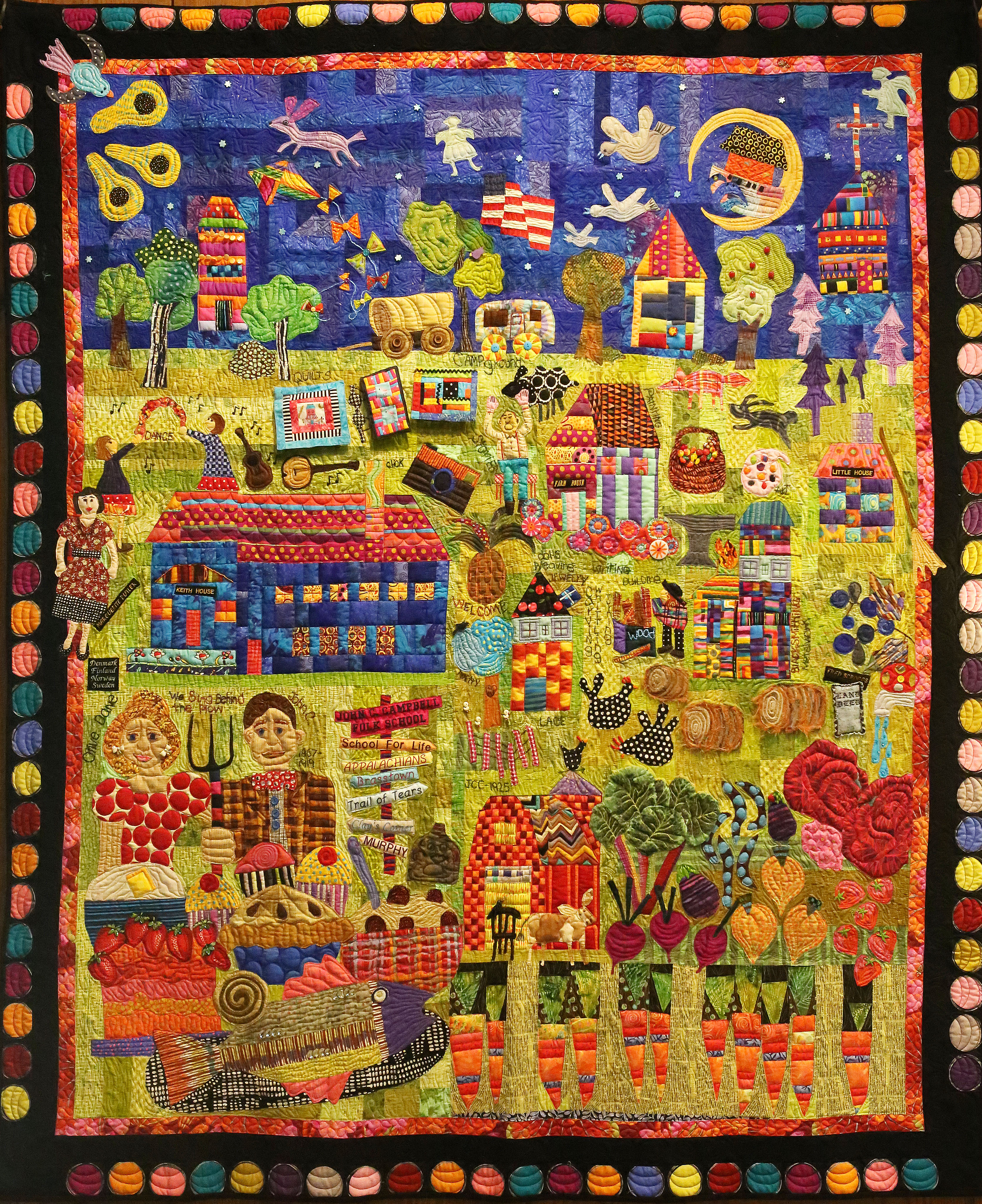 Instructor Mary Lou Weidman of Spokane, Washington recently sent us a quilt depicting the story of the Folk School. Three and a half years in the making, the wonderfully colorful and imaginative quilt is hanging on display in the Community Room of Keith House.
Instructor Mary Lou Weidman of Spokane, Washington recently sent us a quilt depicting the story of the Folk School. Three and a half years in the making, the wonderfully colorful and imaginative quilt is hanging on display in the Community Room of Keith House.
"I was told about JCC by instructor DeeDee Triplett who told me that making money teaching was not the main reason for being there. And the first time I taught there I knew just what she meant. The people, the feeling of community and joy was what it was about. Meeting people from all over in the dining room and hearing experiences and seeing people help each other and in the end hug and wave "Goodbye" was lovely. People were happy with projects and a week of loveliness in the meadows and gardens and just walking along the paths is joyful. Imagining those that came before you is a nice thing to do also while you look at butterflies and nature and lovely wrought iron and folk art here and there. It is a pleasure to come and enjoy all there is, including music and dancing at night. This is a great place to work on gratitude and all that God can provide in one lovely place.
I decided to work on a quilt because there is so much to tell stories about there. Once I got into designing it, I realized that it should be a series of quilts because there is so much to tell and not enough room in one quilt. But I did the best I could and wanted to have John and Olive and Marguerite and the deed for the property from Fred Scroggs as that seemed very important to say. I worked for over three years on this quilt and Kathy Woods quilted it for me. Connie Donaldson my neighbor worked on it too and we both read many of the catalogues and other things online for ideas. Then we had too many ideas and so we did the best we could.
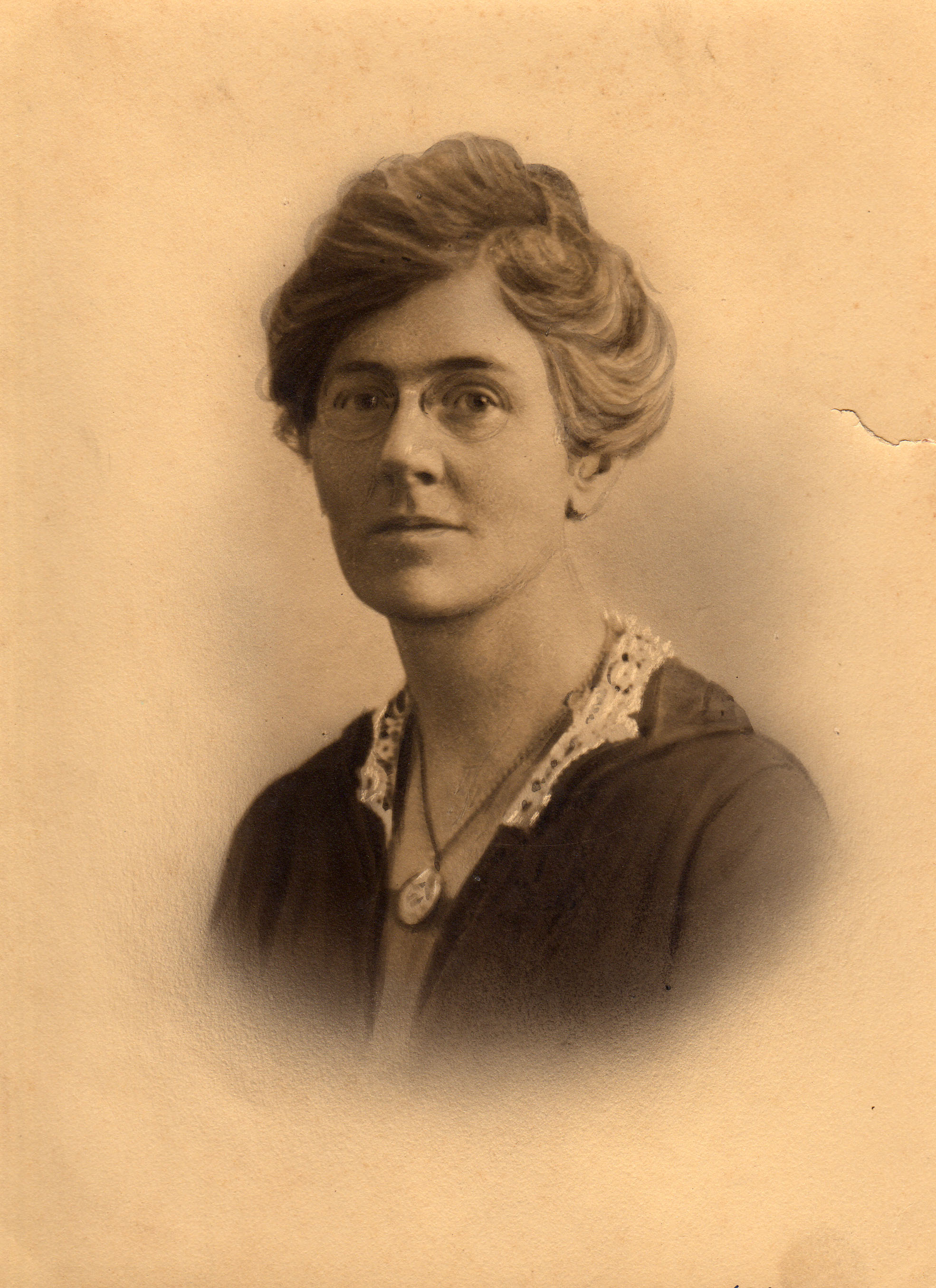 Olive Dame Campbell[/caption]
Olive Dame was born the daughter of a middle class New England family of Mayflower descent. Her father was a talented botany teacher and school principal. A gifted mother taught her early the love of art and music. She enjoyed an active, rich youth that developed an inquiring mind and strong, determined will. These attributes would serve her well in the coming years of adventure with future husband, John C. Campbell, and later as the founder and director of the Folk School she named in his honor. Though less well known, she became one of the leading social reformers of her time.
After graduating from Tufts College in 1903, she taught literature several years before planning a vacation voyage to Scotland in 1906. On the voyage, she met John Campbell who was traveling to his ancestral homeland to recuperate from the loss of a wife and the stress of being President of Piedmont College. Olive was a smart, talented and dedicated Christian woman with a great sense of humor. She had indeed been called to serve humanity through education. In these ways, she was a lot like John. By trip’s end, they were engaged. Olive and John married in 1907 in her home town in Medford, Massachusetts.
Olive Dame Campbell[/caption]
Olive Dame was born the daughter of a middle class New England family of Mayflower descent. Her father was a talented botany teacher and school principal. A gifted mother taught her early the love of art and music. She enjoyed an active, rich youth that developed an inquiring mind and strong, determined will. These attributes would serve her well in the coming years of adventure with future husband, John C. Campbell, and later as the founder and director of the Folk School she named in his honor. Though less well known, she became one of the leading social reformers of her time.
After graduating from Tufts College in 1903, she taught literature several years before planning a vacation voyage to Scotland in 1906. On the voyage, she met John Campbell who was traveling to his ancestral homeland to recuperate from the loss of a wife and the stress of being President of Piedmont College. Olive was a smart, talented and dedicated Christian woman with a great sense of humor. She had indeed been called to serve humanity through education. In these ways, she was a lot like John. By trip’s end, they were engaged. Olive and John married in 1907 in her home town in Medford, Massachusetts.
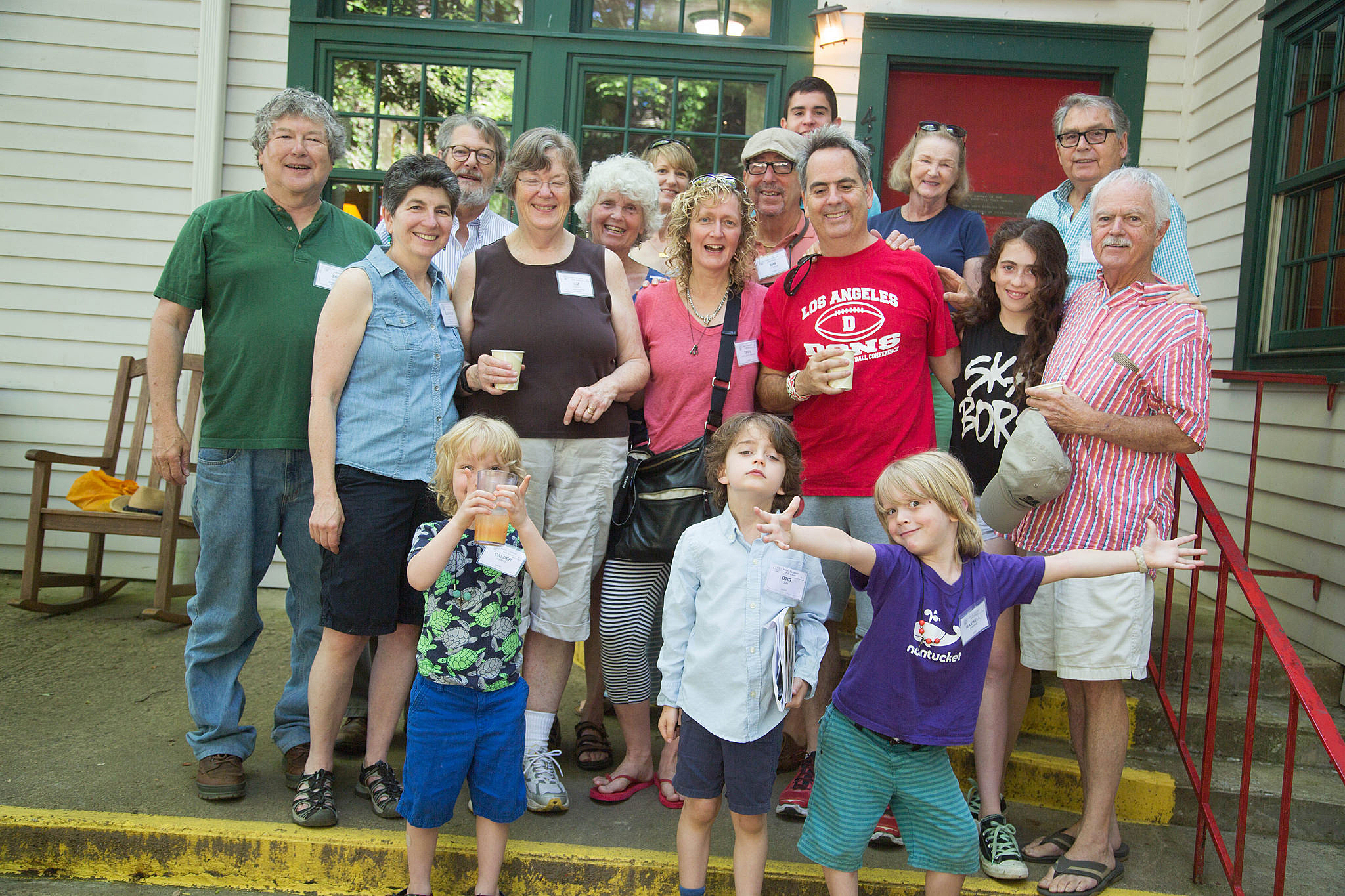 The Olive Dame family gather for a quick photo in front of Keith House. Kids, standing left to right: Calder LaFollette Huck, Otis Cary, Maxwell LaFollette Huck. Second row, left to right Toby Sackton (married to Marcia), Elisabeth Sackton (married to Liz Coolidge), Liz Coolidge, Tavia LaFollette, Donick Cary, Amadi Cary, Richard Cary. Back row, left to right: Jan Davidson, Marcia Butman, Kim Huffman Cary, Kim Huffman, Josh Wipf (behind Kim), Jeanne Huffman, Lorin Cary.[/caption]
Members of Folk School founder Olive Dame Campbell's family gathered here during a recent weekend in June (12-14) for a mini-family reunion and a chance to experience the Folk School. While some members took classes in Photography, Spinning, and Gardening, others spent time on campus, browsing the school’s archives, visiting and meeting with Folk School staff and community members. I recently caught up with Marcia Butman (Olive was Marcia's Great Aunt) and Tavia LaFollette Zabriske (Olive was her Great Great Aunt) to ask them about their thoughts about the Folk School and to learn more about their family’s connection to Olive.
KG: Tell us why you decided to gather your family here for a mini-reunion at the Folk School.
MB: I had been reading Olive’s diary and sending it out on a daily basis to a large group of extended family, calling it “Dame A Day.” I sent out the year of Olive’s baby Jane’s life, from April 1912 through January 1913. I think this really involved our family in Olive’s life, and we began talking about holding a reunion at the school. Toby and I visited the school twice in the past ten years and I also visited with my daughter for the day when we were at The Great Smokies. We also hosted Jan and Nanette in Nantucket when they came to do a talk and concert. Our relationship to them made me feel it would be possible to arrange a family visit. Jan and Nanette are such special and wonderful welcoming people, they were very positive and enthusiastic about the idea of a reunion and I knew they would help us arrange a reunion. And they did so much to make the weekend great.
However, it seemed very difficult to come up with a date. Then Lorin Cary, whose brother, Richard lives in Asheville, said he was planning to visit on Richard June 12, after his grandson’s graduation from High School in Toledo, and both of them were going to go visit the school. Once one person said they were definitely coming, it all fell into place. (Olive was also Great Aunt to both Lorin and Richard. They are the sons of Olive's niece June and Harry Cary, who lived and worked at the Folk School from 1938-41).
TLZ: I have grown up with stories and artifacts. This was an opportunity to learn and share with family, first hand, in a place that has captured and treasures cultural heritage. What a unique opportunity!
The Olive Dame family gather for a quick photo in front of Keith House. Kids, standing left to right: Calder LaFollette Huck, Otis Cary, Maxwell LaFollette Huck. Second row, left to right Toby Sackton (married to Marcia), Elisabeth Sackton (married to Liz Coolidge), Liz Coolidge, Tavia LaFollette, Donick Cary, Amadi Cary, Richard Cary. Back row, left to right: Jan Davidson, Marcia Butman, Kim Huffman Cary, Kim Huffman, Josh Wipf (behind Kim), Jeanne Huffman, Lorin Cary.[/caption]
Members of Folk School founder Olive Dame Campbell's family gathered here during a recent weekend in June (12-14) for a mini-family reunion and a chance to experience the Folk School. While some members took classes in Photography, Spinning, and Gardening, others spent time on campus, browsing the school’s archives, visiting and meeting with Folk School staff and community members. I recently caught up with Marcia Butman (Olive was Marcia's Great Aunt) and Tavia LaFollette Zabriske (Olive was her Great Great Aunt) to ask them about their thoughts about the Folk School and to learn more about their family’s connection to Olive.
KG: Tell us why you decided to gather your family here for a mini-reunion at the Folk School.
MB: I had been reading Olive’s diary and sending it out on a daily basis to a large group of extended family, calling it “Dame A Day.” I sent out the year of Olive’s baby Jane’s life, from April 1912 through January 1913. I think this really involved our family in Olive’s life, and we began talking about holding a reunion at the school. Toby and I visited the school twice in the past ten years and I also visited with my daughter for the day when we were at The Great Smokies. We also hosted Jan and Nanette in Nantucket when they came to do a talk and concert. Our relationship to them made me feel it would be possible to arrange a family visit. Jan and Nanette are such special and wonderful welcoming people, they were very positive and enthusiastic about the idea of a reunion and I knew they would help us arrange a reunion. And they did so much to make the weekend great.
However, it seemed very difficult to come up with a date. Then Lorin Cary, whose brother, Richard lives in Asheville, said he was planning to visit on Richard June 12, after his grandson’s graduation from High School in Toledo, and both of them were going to go visit the school. Once one person said they were definitely coming, it all fell into place. (Olive was also Great Aunt to both Lorin and Richard. They are the sons of Olive's niece June and Harry Cary, who lived and worked at the Folk School from 1938-41).
TLZ: I have grown up with stories and artifacts. This was an opportunity to learn and share with family, first hand, in a place that has captured and treasures cultural heritage. What a unique opportunity!
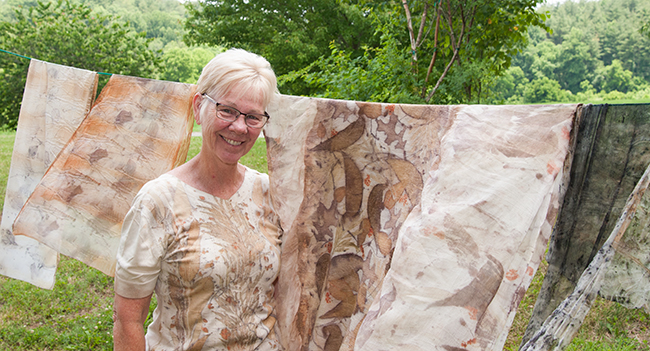 Kathy Hays displays her eco print creations outside the Wet Room.[/caption]
[caption id="attachment_13334" align="alignright" width="234"]
Kathy Hays displays her eco print creations outside the Wet Room.[/caption]
[caption id="attachment_13334" align="alignright" width="234"]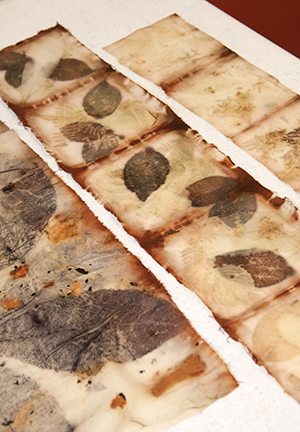 Class projects[/caption]
I stopped by the Wet Room to visit Kathy Hays' recent class "Eco Printing Meets Felt Making" to see what they were creating. I talked to Kathy about her craft and the joys of eco printing. Enjoy our interview!
CP: Tell me about where you're from, what you do there, and about your craft.
KH: I’m from Florida, an unusual area for felt making due to the climate. I began making felt here at the Folk School in 1999. After struggling and trying to figure how to make felt on my own, I was able to come here and after the first day, it was like all my questions were answered! The rest of the week was purely a bonus.
CP: How is Nuno Felting different from other felting?
KH: Felt making is wool fibers being arranged and then adding soap, water, and agitation. In the case of Nuno Felting, you are merging fibers through another fabric. The term is a little ambiguous. That fabric can be cotton, linen... anything that is thin enough for it to come through. It creates a unique texture when it does that.
Class projects[/caption]
I stopped by the Wet Room to visit Kathy Hays' recent class "Eco Printing Meets Felt Making" to see what they were creating. I talked to Kathy about her craft and the joys of eco printing. Enjoy our interview!
CP: Tell me about where you're from, what you do there, and about your craft.
KH: I’m from Florida, an unusual area for felt making due to the climate. I began making felt here at the Folk School in 1999. After struggling and trying to figure how to make felt on my own, I was able to come here and after the first day, it was like all my questions were answered! The rest of the week was purely a bonus.
CP: How is Nuno Felting different from other felting?
KH: Felt making is wool fibers being arranged and then adding soap, water, and agitation. In the case of Nuno Felting, you are merging fibers through another fabric. The term is a little ambiguous. That fabric can be cotton, linen... anything that is thin enough for it to come through. It creates a unique texture when it does that.
...
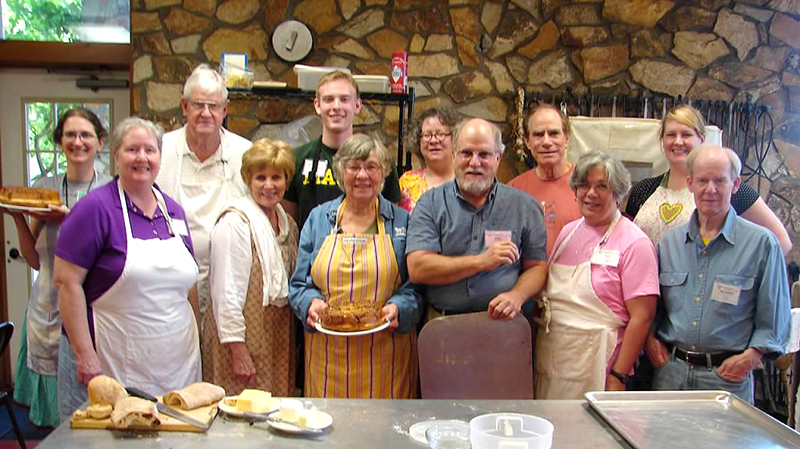 The "Science of Bread" Class Photo, May 2015[/caption]
Magical. That’s the word used over and over to describe a week at the Folk School. And there’s always something that makes the visit extra special: last May it was the baby barn swallows peeking over the edges of their nests in the rafters outside Davidson Hall.
The "Science of Bread" Class Photo, May 2015[/caption]
Magical. That’s the word used over and over to describe a week at the Folk School. And there’s always something that makes the visit extra special: last May it was the baby barn swallows peeking over the edges of their nests in the rafters outside Davidson Hall.
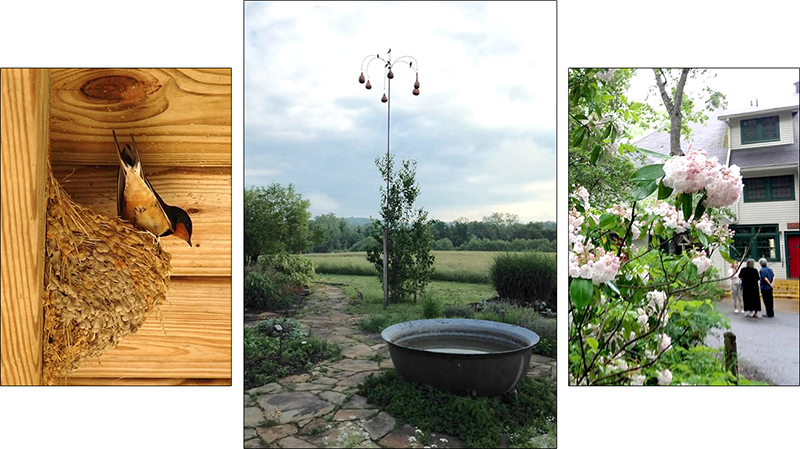 This year it was the mountain laurel in full bloom; the mother-to-be barn swallows sat patiently atop their nests. The Folk School is a magical place, but also, when you’re there, you slow down and pay attention to things like the birds and flowers.
[caption id="attachment_13066" align="alignright" width="215"]
This year it was the mountain laurel in full bloom; the mother-to-be barn swallows sat patiently atop their nests. The Folk School is a magical place, but also, when you’re there, you slow down and pay attention to things like the birds and flowers.
[caption id="attachment_13066" align="alignright" width="215"]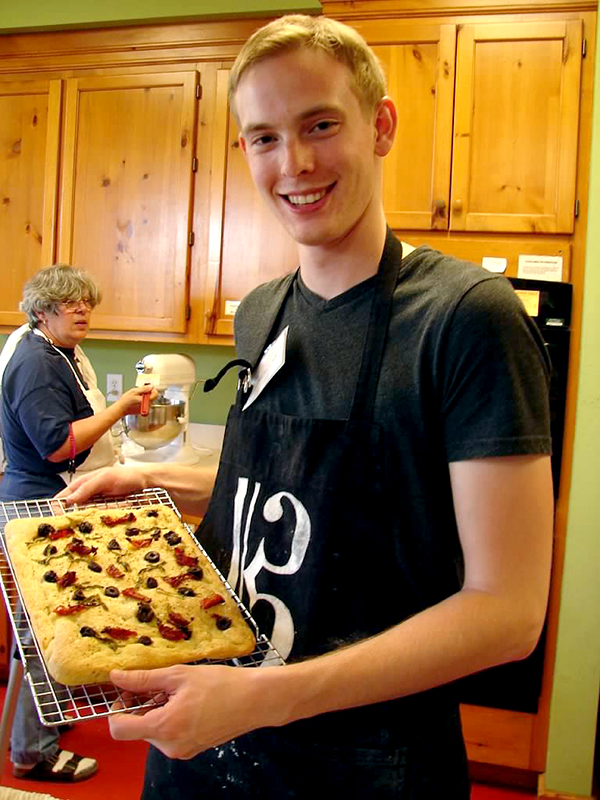 Nicholas holds the focaccia fresh out of the oven.[/caption]
I was at the Folk School last week to teach my annual “Science of Bread” class—not a magical name by any means, but bread-making can be wondrous even when you know about the microorganisms and molecules that make it work. In addition to making dozens of loaves, the class started a sourdough starter by attracting wild yeasts and bread-making bacteria from the air into a container of flour and water. They also braved the production of salt-rising bread, a first for me. Making salt-rising bread is similar to creating a sourdough starter in that ingredients (in our case, raw potatoes, corn meal, sugar, and baking soda) are left out to attract microorganisms that cause the bread to rise when the dough is mixed the next day. (“Salt-rising” is a misnomer.) The ingredients are kept at 110 degrees, however, so that the microorganisms attracted to the mixture are different than the usual ones; this results in the unique flavor and aroma of salt-rising bread.
Nicholas holds the focaccia fresh out of the oven.[/caption]
I was at the Folk School last week to teach my annual “Science of Bread” class—not a magical name by any means, but bread-making can be wondrous even when you know about the microorganisms and molecules that make it work. In addition to making dozens of loaves, the class started a sourdough starter by attracting wild yeasts and bread-making bacteria from the air into a container of flour and water. They also braved the production of salt-rising bread, a first for me. Making salt-rising bread is similar to creating a sourdough starter in that ingredients (in our case, raw potatoes, corn meal, sugar, and baking soda) are left out to attract microorganisms that cause the bread to rise when the dough is mixed the next day. (“Salt-rising” is a misnomer.) The ingredients are kept at 110 degrees, however, so that the microorganisms attracted to the mixture are different than the usual ones; this results in the unique flavor and aroma of salt-rising bread.
A big congratulations to Brasstown...
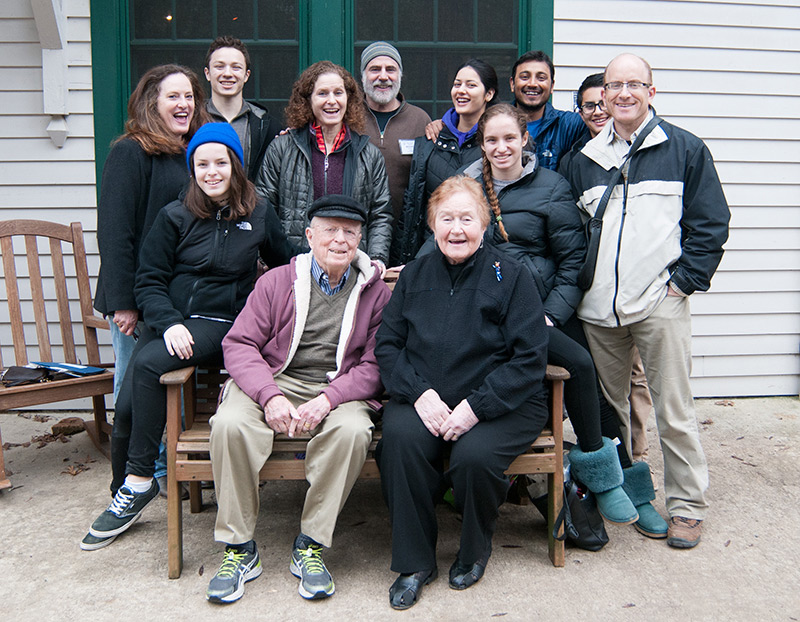 (Front Row) Dr. Fred & Mrs. Martha U. Goldner (Second Row L. to R.) Hannah Niederman, Francie Niederman, Natalie Niederman, Fredjoseph Goldner, (Third Row L. to R.) Cynthia Goldner, Aaron Niederman, Michael Niederman, Sana Singh, Prash Singh, and Julian Goldner.[/caption]
[caption id="attachment_12848" align="alignright" width="244"]
(Front Row) Dr. Fred & Mrs. Martha U. Goldner (Second Row L. to R.) Hannah Niederman, Francie Niederman, Natalie Niederman, Fredjoseph Goldner, (Third Row L. to R.) Cynthia Goldner, Aaron Niederman, Michael Niederman, Sana Singh, Prash Singh, and Julian Goldner.[/caption]
[caption id="attachment_12848" align="alignright" width="244"]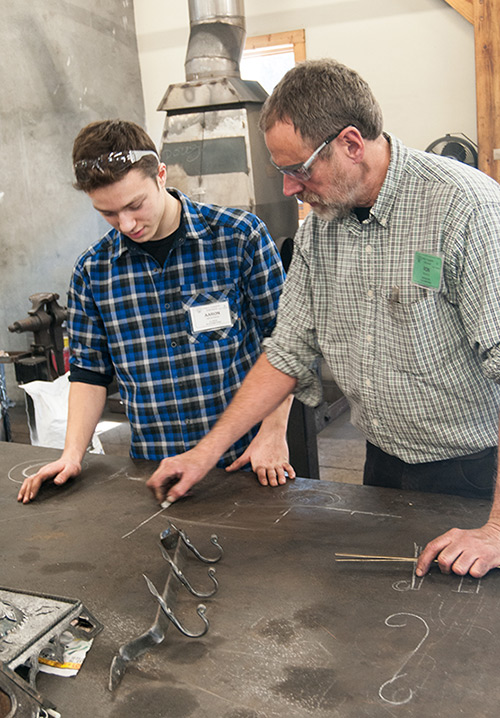 Aaron Niederman plans his Blacksmithing project with instructor Ron Nichols.[/caption]
While Fred & Martha toasted their 60th, one of their two daughters, Francie Niederman, of Skokie, IL, also celebrated her 20th anniversary with her husband Michael. Three generations of family members and their friends came to the Folk School to take a variety of Weekend classes including: Blacksmithing, Jewelry, Enameling, Drawing, Woodturning, and Woodworking. Creativity seems to run in the family. Their daughter, Cynthia, promotes her innovative art at Makin Time Clocks and their grandson, Julian, was a Silver Medalist in the most recent Scholastic Art Awards Competition.
Seeing them in the studio, at our family-style meals in the Dining Hall, and at Show and Tell was delightful. They made it look like the most incredible family vacation ever. I talked with Martha about her Folk School experience and what it was like to have her family congregate in Brasstown for this very special occasion:
CP: Congratulations once again on your anniversary! Was this your first trip to the Folk School?
MG: Fred and I had a previous experience at JCCFS around the same time of year in 2011. We took Bistro Cooking and Fiber Arts & Knitting.
[caption id="attachment_12840" align="alignleft" width="286"]
Aaron Niederman plans his Blacksmithing project with instructor Ron Nichols.[/caption]
While Fred & Martha toasted their 60th, one of their two daughters, Francie Niederman, of Skokie, IL, also celebrated her 20th anniversary with her husband Michael. Three generations of family members and their friends came to the Folk School to take a variety of Weekend classes including: Blacksmithing, Jewelry, Enameling, Drawing, Woodturning, and Woodworking. Creativity seems to run in the family. Their daughter, Cynthia, promotes her innovative art at Makin Time Clocks and their grandson, Julian, was a Silver Medalist in the most recent Scholastic Art Awards Competition.
Seeing them in the studio, at our family-style meals in the Dining Hall, and at Show and Tell was delightful. They made it look like the most incredible family vacation ever. I talked with Martha about her Folk School experience and what it was like to have her family congregate in Brasstown for this very special occasion:
CP: Congratulations once again on your anniversary! Was this your first trip to the Folk School?
MG: Fred and I had a previous experience at JCCFS around the same time of year in 2011. We took Bistro Cooking and Fiber Arts & Knitting.
[caption id="attachment_12840" align="alignleft" width="286"]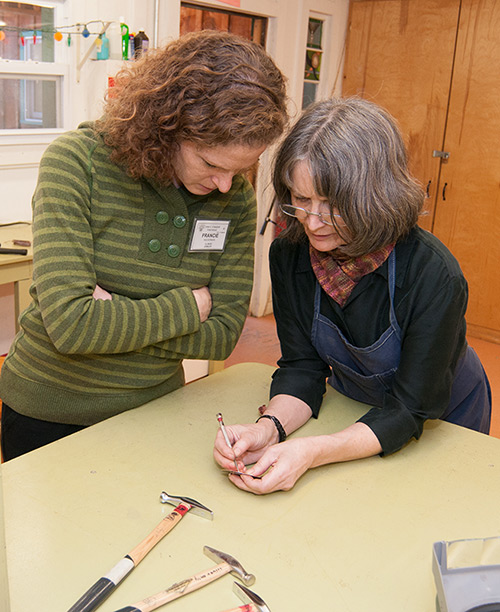 Francie learns a jewelry technique from Kay Patterson.[/caption]
CP: What made you decide to pick the Folk School as a destination for your anniversary celebration?
MG: We identified our anniversary celebration with family. A weekend of the exact dates was in the catalogue and it was a perfect place away from everyone's usual environment. A place of unknown demands on them, yet programmed for each one to be surprised and inspired.
CP: How many of your family members congregated at the Folk School? Who came from the furthest destination?
MG: Of the twelve members there were three couples. Our son came from San Jose, Costa Rica.
CP: How did you decide what classes to take?
MG: When the idea was hatched we distributed the outline and description of what was available so they quickly made choices before the classes filled up.
Francie learns a jewelry technique from Kay Patterson.[/caption]
CP: What made you decide to pick the Folk School as a destination for your anniversary celebration?
MG: We identified our anniversary celebration with family. A weekend of the exact dates was in the catalogue and it was a perfect place away from everyone's usual environment. A place of unknown demands on them, yet programmed for each one to be surprised and inspired.
CP: How many of your family members congregated at the Folk School? Who came from the furthest destination?
MG: Of the twelve members there were three couples. Our son came from San Jose, Costa Rica.
CP: How did you decide what classes to take?
MG: When the idea was hatched we distributed the outline and description of what was available so they quickly made choices before the classes filled up.
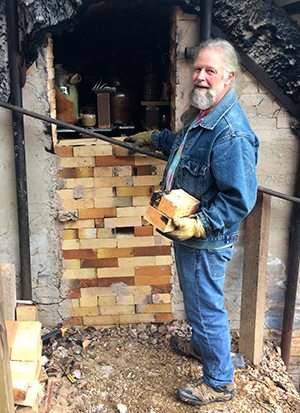 Rob unbricks the kiln.[/caption]
It's like Christmas Eve over at Smoke in the Mountains Pottery today because it's the day before the big wood kiln will be opened and unloaded. Many potters from all over the region contribute pots to be fired the traditional way in Rob Withrow's huge wood kiln. This is Rob's 13th wood firing at his studio. I stopped by and caught him taking a little peek inside the chamber and took the opportunity to talk to him about the firing and clay in general. Join us in the sneak peek...
CP: So what are you doing right now?
RW: I'm unbricking this kiln here that's been cooling for five days. We heated it up to 2500 degrees using only wood, and now it's like Christmas! You open it up and see what's inside and this time the kiln fired so beautifully; it's such a joy.
CP: Nice, How many time have you fired this kiln?
RW: It's been a hard road but I stuck with it, and by golly the community came forth and helped me all along the way. I fired it nine times unsuccessfully. A weaker man would have caved or a smarter man would have stopped, but I kept going and here we are! The community came together and knew I was having problems. We put a new chimney on it and it works like a charm now. Now it's a third of the wood, and a third of the time (than when we first started).
[caption id="attachment_12738" align="aligncenter" width="565"]
Rob unbricks the kiln.[/caption]
It's like Christmas Eve over at Smoke in the Mountains Pottery today because it's the day before the big wood kiln will be opened and unloaded. Many potters from all over the region contribute pots to be fired the traditional way in Rob Withrow's huge wood kiln. This is Rob's 13th wood firing at his studio. I stopped by and caught him taking a little peek inside the chamber and took the opportunity to talk to him about the firing and clay in general. Join us in the sneak peek...
CP: So what are you doing right now?
RW: I'm unbricking this kiln here that's been cooling for five days. We heated it up to 2500 degrees using only wood, and now it's like Christmas! You open it up and see what's inside and this time the kiln fired so beautifully; it's such a joy.
CP: Nice, How many time have you fired this kiln?
RW: It's been a hard road but I stuck with it, and by golly the community came forth and helped me all along the way. I fired it nine times unsuccessfully. A weaker man would have caved or a smarter man would have stopped, but I kept going and here we are! The community came together and knew I was having problems. We put a new chimney on it and it works like a charm now. Now it's a third of the wood, and a third of the time (than when we first started).
[caption id="attachment_12738" align="aligncenter" width="565"]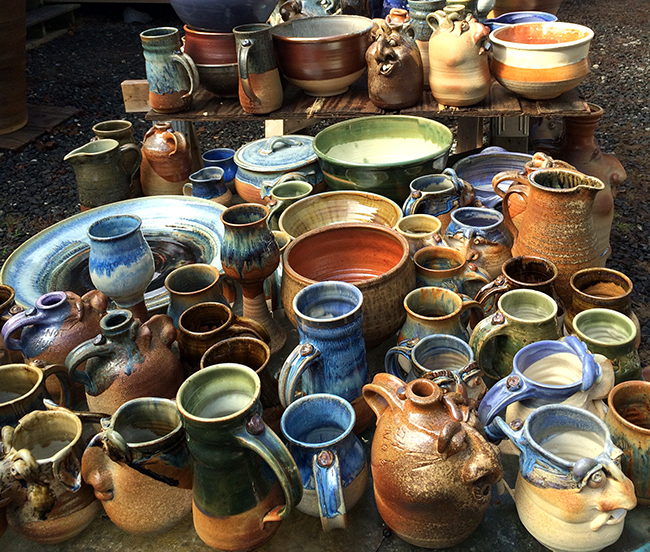 Beautiful pots from the March 2015 wood firing[/caption]
Beautiful pots from the March 2015 wood firing[/caption]


